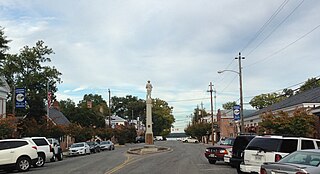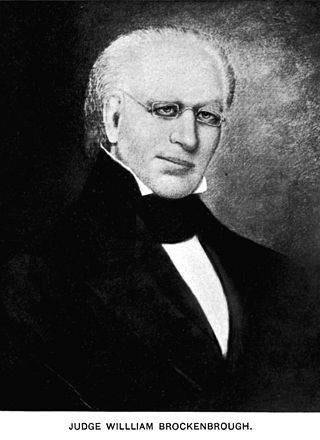
Essex County is a county located in the Middle Peninsula in the U.S. state of Virginia; the peninsula is bordered by the Rappahannock River on the north and King and Queen County on the south. As of the 2020 census, the population was 10,599. Its county seat is Tappahannock.

Tappahannock is the oldest town in Essex County, Virginia, United States. The population was 2,375 at the 2010 census, up from 2,068 at the 2000 census. Located on the Rappahannock River, Tappahannock is the county seat of Essex County. Its name comes from an Algonquian language word lappihanne, meaning "Town on the rise and fall of water" or "where the tide ebbs and flows." The Rappahannock is a tidal estuary from above this point and downriver to its mouth on Chesapeake Bay.

The Northern Neck is the northernmost of three peninsulas on the western shore of the Chesapeake Bay in the Commonwealth of Virginia. The Potomac River forms the northern boundary of the peninsula; the Rappahannock River demarcates it on the south. The land between these rivers was formed into Northumberland County in 1648, prior to the creation of Westmoreland County and Lancaster County. The Northern Neck encompasses the following Virginia counties: Lancaster, Northumberland, Richmond, King George and Westmoreland; it had a total population of 50,158 as of the 2020 census.

The Rappahannock River is a river in eastern Virginia, in the United States, approximately 195 miles (314 km) in length. It traverses the entire northern part of the state, from the Blue Ridge Mountains in the west where it rises, across the Piedmont to the Fall Line, and onward through the coastal plain to flow into the Chesapeake Bay, south of the Potomac River.

The White House of the Confederacy is a historic house located in the Court End neighborhood of Richmond, Virginia. Built in 1818, it was the main executive residence of the sole President of the Confederate States of America, Jefferson Davis, from August 1861 until April 1865. It was viewed as the Confederate States counterpart to the White House in Washington, D.C. It currently sits on the campus of Virginia Commonwealth University.
John Mercer Brockenbrough was a farmer and a Confederate colonel in the American Civil War.

The Rappahannock are a federally recognized tribe in Virginia and one of the eleven state-recognized tribes. They are made up of descendants of several small Algonquian-speaking tribes who merged in the late 17th century. In January 2018, they were one of six Virginia tribes to gain federal recognition by passage of the Thomasina E. Jordan Indian Tribes of Virginia Federal Recognition Act of 2017.

The Octagon House, also known as the Colonel John Tayloe III House, is a house located at 1799 New York Avenue, Northwest in the Foggy Bottom neighborhood of Washington, D.C. It was built in 1799 for John Tayloe III. In September 1814, after the British destroyed the White House during the War of 1812, for six months the Octagon House served as the residence of United States president James Madison and first lady Dolley Madison. It is one of only five houses to serve as the presidential residence in the history of the United States of America, and one of only three that still stand.

Mount Airy, near Warsaw in Richmond County, Virginia, is the first neo-Palladian villa mid-Georgian plantation house built in the United States. It was constructed in 1764 for Colonel John Tayloe II, perhaps the richest Virginia planter of his generation, upon the burning of his family's older house. John Ariss is the attributed architect and builder. Tayloe's daughter, Rebecca and her husband Francis Lightfoot Lee, one of the only pair of brothers to sign the Declaration of Independence are buried on the estate, as are many other Tayloes. Before the American Civil War, Mount Airy was a prominent racing horse stud farm, as well as the headquarters of about 10-12 separate but interdependent slave plantations along the Rappahannock River. Mount Airy is listed on the National Register of Historic Places as a National Historic Landmark as well as on the Virginia Landmarks Register and is still privately owned by Tayloe's descendants.

Spencer Roane was a Virginia lawyer, politician and jurist. He served in the Virginia House of Delegates for six years and a year in the Commonwealth's small executive branch. The majority of his public career was as a judge, first of the General Court and later on the Court of Appeals.

William Brockenbrough was a Virginia lawyer, planter, politician and judge, including on what became the Supreme Court of Virginia.
Joseph W. Chinn was a Virginia lawyer and judge.
Joseph William Chinn was a Virginia lawyer, plantation owner and politician who served in both houses of the Virginia General Assembly and in the United States House of Representatives.
St. Margaret's School is an independent, Episcopal, all-girls school located in the town of Tappahannock, Virginia, United States, on the banks of the Rappahannock River. The school is 45 miles northeast of the Richmond metro area, 100 miles southeast of the Washington metro area, and 75 miles northwest of the Hampton Roads metro area. St. Margaret's is governed by the Episcopal Diocese of Virginia. St. Margaret's opened in 1921 with 14 students and now has an enrollment of 98 girls. The student body includes international students from 18 different countries, and domestic boarding students from 17 states and Washington, D.C. Day students make up 20 percent of the student body.
Thomas Croxton was a U.S. Representative from Virginia.

John White Brockenbrough was a Virginia attorney, law professor, U.S. District Judge of the United States District Court for the Western District of Virginia, and Confederate States congressman and district judge.
Thomas Mann Randolph Sr. served in the Virginia House of Burgesses, the Revolutionary conventions of 1775 and 1776, and the Virginia state legislature. Married twice, he fathered 15 children. One marriage was to a cousin, Anne Cary, with whom they had 13 children. His second marriage, which resulted in two children, caused a dissention among family members. The youngest son, with the same name as his half-brother, Thomas Mann Randolph, inherited the family plantation, Tuckahoe plantation. Randolph expanded upon the house that began to be built during his parents' short marriage. Orphaned as a young boy, Randolph continued work on Tuckahoe when he came of age. He also purchased Salisbury house, which was used during his lifetime as a hunting lodge.
Catharine Flood McCall was an early 19th-century American businesswoman, during a time when women generally did not operate businesses or manage finances in America. Before and during the American Revolutionary War, she was educated in Scotland and London. She inherited Cedar Grove and Clydeside plantations following the death of her maternal grandfather, Dr. Nicholas Flood in 1776. Parliament passed a law that prevented people from traveling to the Thirteen British Colonies during the war. McCall and her father were unable to return to Virginia until 1782. She was among the largest slaveholders in Essex County, Virginia, and received an inheritance from her maternal grandfather of the Cedar Grove and Clydeside plantations.
Archibald McCall was a wealthy merchant and landowner. Born in Scotland, he settled in Colonial Virginia in the 1750s. He supported the Stamp Act 1765, he required customers to pay the British tax, and was tar and feathered by a mob for his position. Although he was considered a Loyalist, he signed the Virginia Nonimportation Resolutions of 1770 along with Thomas Jefferson, George Washington, and other patriots. There is evidence that he supplied Lord Dunmore's troops with food before he left for Britain in 1775. He stayed in Britain longer than he expected, because he could not get permission to return to Virginia.












